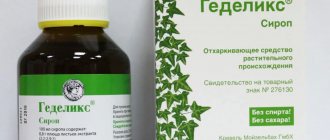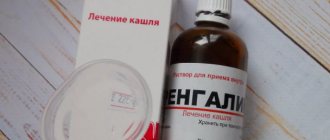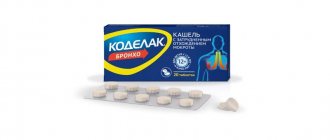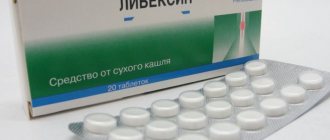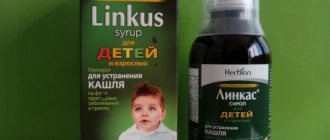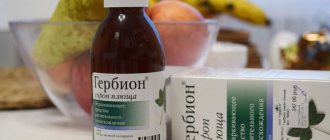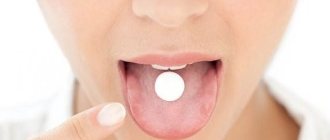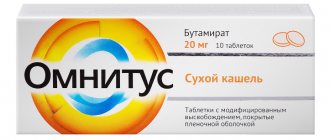Read on this page:
Glycodin contains terpene hydrate, which has an expectorant effect and also makes coughing less viscous. Another active ingredient of the drug is levomenthol. It eliminates spasms and helps relieve symptoms of acute rhinitis, bronchitis, pharyngitis and laryngitis. Together, these substances interrupt the chain of cough reflexes and alleviate the patient’s condition.
Dextromethorphan penetrates almost completely into the gastrointestinal tract, undergoes biochemical transformations in the liver, and is excreted from the body along with urine. Terpin hydrate enters the bloodstream unchanged and is excreted from the body through the respiratory tract, with liquids: urine and sweat. Biological fluids acquire a specific odor due to the content of terpin hydrate.
Pharmacodynamics
Glycodin cough syrup contains dextromethorphan, a substance that can suppress the activity of the cough reflex in the brain region, thereby eliminating the occurrence of dry cough of various etiologies. If the dosage prescribed by the doctor or specified in the prescription is followed, it does not have a pronounced narcotic effect on a person, characterized by high drowsiness and loss of sensitivity. The action begins up to half an hour after consuming the syrup, the maximum duration reaches six hours in adults and nine in children.
Terpin hydrate in the liquid has a pronounced expectorant effect. Terpin hydrate increases the ability of the glands of the epithelial tissue of the respiratory center region to secrete secretions, thereby increasing the volume of sputum and its viscosity, which greatly facilitates the process of its release during coughing and helps cleanse the lower respiratory tract of accumulated secretions.
The presence of levomenthol in the drug guarantees the elimination of spasms during exacerbation of inflammation of the mucous membrane of the throat (pharyngitis), upper respiratory tract (rhinitis) or bronchi (bronchitis), accompanied by a strong urge to cough.
Pharyngitis
Recreational Use of Glycodin
Glycodin has changed its status as a pharmaceutical drug several times. Until 2009, it was only available with a doctor's prescription. Then it stopped being a prescription drug. But in 2011-2012, it was again added to the list of controlled substances and began to be available only by prescription.
For recreational use, the active substance of the drug, dextromethorphan, is of interest. If its dosage exceeds the medical dose, it behaves like a psychostimulant and changes the state of consciousness. It is dextromethorphan that is the goal of drug addicts; very quickly they came up with ways to extract pure psychoactive substance from the drug, which is used to obtain euphoria.
In addition, for non-medical purposes, Glycodin syrup is used unchanged, only up to one whole bottle is drunk per dose. This causes drug intoxication, up to the appearance of hallucinations. If you use the medicine in an increased dosage regularly, it causes real drug addiction with all the ensuing consequences. A person develops mental dependence on the drug, and then there is a physical need for its use, which manifests itself in the occurrence of abstinence syndrome or withdrawal syndrome.
Drug addicts who use glycodin experience tachycardia, headaches, problems with the cardiovascular system, breathing, and gastrointestinal dysfunction. In case of an overdose of the drug, cardiac and respiratory arrest may occur. A seemingly harmless cough syrup can become deadly if used for other purposes.
Pharmacokinetics
The pharmacokinetic effect of the drug is characterized by total absorption of the drug into the gastrointestinal tract with the origin of metabolic effects in the liver. The peak concentration of Glycodin in the blood occurs two hours after consumption. Approximately 45% of the main component, dextromethorphan, is excreted from the body by the kidneys along with urine.
Terpin hydrate is quickly absorbed from the walls of the gastrointestinal tract immediately after consuming the drug. Then it enters the bloodstream and circulates in it in its original form. It is eliminated from the body by coughing, sweat and urine. These liquids acquire a very unpleasant odor due to the content of terpin hydrate in them. Some of the drug is oxidized in organs and systems and is excreted by the kidneys along with urine.
Treatment for Glycodin Addiction
Dependence on glycodin is a real drug addiction, despite the fact that the drug that caused it is a pharmaceutical drug. Therefore, treatment includes the standard stages of getting rid of drug addiction. The patient stops taking the drug and a drug course of treatment begins. Its main task is to detoxify the body, removing toxic drug wastes accumulated there during use from the tissues and organs of the body.
As we noted above, glycodin causes many serious side effects. Therefore, in addition to intoxication, glycodin addicts at the stage of drug treatment have to normalize the functioning of the heart, lungs, and gastrointestinal tract, and eliminate problems with blood pressure and migraines.
When health is in order and the patient has gotten rid of the physical craving for the drug, the rehabilitation stage begins. At this time, psychologists work with the addict, he finds the internal causes of addiction in himself and eliminates them with the support of a doctor using various psychotherapeutic means. This is how psychological dependence on the drug goes away.
The patient then returns to normal social relationships. First, he prepares for this in a rehabilitation center, undergoing training in the basics of healthy communication and gaining practical skills during group classes and while living in the microsociety of the center. During this period of time, psychologists also work with relatives of the rehabilitator, who attend lectures and classes for codependents, learn how to behave correctly with a former drug addict, support him and not fall into a state of codependency. After discharge from the center, the former patient can attend support groups, receive psychological assistance, and, if necessary, assistance in finding employment.
Instructions for use
The drug is administered enterally. It is necessary to read the instructions for use of Glycodin to take into account the indications and contraindications according to the use of the drug in a particular case. The duration of use and the exact dosage of Glycodin should be strictly regulated by the attending physician.
The dosage of the drug is prescribed by the attending physician
It is important to include the following nuances for special instructions for the use of Glycodin:
- People suffering from diabetes mellitus should pay attention to the sucrose content in the drug: 3250 mg (less than 1 XE).
- During the initial administration of the drug and abrupt withdrawal of the drug, no specific features of the final effect were recorded.
- If one or more stages of using the syrup are missed, no emergency action is required from the paramedic or attending physician.
- If the patient’s history does not indicate concomitant kidney diseases, you can adhere to the dosage indicated in the prescription according to the age and other characteristics of the patient’s health condition.
- There is no experience of taking the drug in patients with chronic renal failure or liver failure.
- When using Glycodin, you must exercise maximum caution while driving a vehicle or at work that requires increased concentration and carries certain risks to the health or vital functions of the worker.
- It is not recommended to combine this drug with MAO inhibitors.
Overdose
Overdose symptoms
- Psychomotor agitation
- Dyspeptic disorders
- Rapid pulse
- Respiratory depression
- Apathy
- Lethargy
- Dizziness
- Strong desire to sleep
- Allergy
- Edema
- Rash
It is not necessary that all these symptoms will occur during an overdose.
If you notice signs of an overdose, it is important to call an ambulance. Doctors will rinse the patient’s stomach, carry out symptomatic treatment, and use an antidote (antidote). The life of the victim can be saved precisely thanks to the gastric lavage procedure. Symptomatic therapy will help relieve symptoms of other concomitant disorders.
Analogues of the drug
Similar syrups and tablets that are effective in combating coughing include the following drugs:
Bromhexine
- Bromhexine;
- Sinecode;
- Solutan;
- Antussin;
- Bronchosan;
- Ambrohexal;
- Codelac;
- Mucosol;
- Codterpin;
- Omnitus;
- Paxeladine;
- Eucabalus;
- Falimint.
The medicinal products indicated in the list contain substances of synthetic and plant origin, the effect of which together guarantees a favorable outcome in the fight against debilitating coughing during the onset of acute and chronic respiratory diseases.
Indications for use and contraindications
Glycodin is prescribed as an independent drug or in complex therapy with other drugs in the treatment of the following clinical cases:
- Laryngitis.
- Bronchitis.
- Sinusitis.
- Rhinitis.
- Pharyngitis.
- Other viral and infectious diseases of the respiratory system, accompanied by a dry cough (for the rapid formation and removal of phlegm from the bronchi).
Glycodin can be prescribed during the rehabilitation period after surgery to relieve cough syndrome after abdominal incisions. The syrup shows the best therapeutic results in the early stages of the disease.
Contraindications to the use of cough syrup:
- individual intolerance to some components of the product;
- bronchial asthma;
- age limit - children under 12 months;
- pregnancy;
- fructose intolerance;
- glucose-galactose malabsorption (due to the presence of sucrose in the composition);
- breastfeeding period.
For children 1-3 years old, medication can only be prescribed by a doctor with individual dosage adjustments.
Side effects from taking
Side effects after consuming the syrup include severe drowsiness, nausea and dizziness. There is also a possibility of allergic reactions such as urticaria and severe itching of the skin. To prevent the occurrence of allergic reactions, it is important to first familiarize yourself with the list of contraindications of the drug and its composition.
If the normal dosage of the drug has been exceeded, a person experiences conditions such as excitability, depression of the respiratory center, decreased blood pressure, dyspeptic symptoms and increased heart rate (tachycardia).
Tachycardia
Emergency help when these symptoms occur is to perform artificial ventilation of the lungs and eliminate the symptoms that arise after using the drug. When using a dosage that exceeds the norm by more than a hundred times, a specific antagonist of the drug is used - naloxone, which suppresses the negative effect after exceeding the dose of Glycodin.
The effect of the syrup is significantly enhanced when Glycodin is taken simultaneously with other antitussive drugs containing certain narcotic substances. They contribute to a significant suppression of coughing in the brain region and suppression of the central nervous system.
Dextromethorphan
We have already noted that the narcotic effect of glycodin occurs due to the psychoactive substance it contains. This is dextromethorphan, which is a fairly strong psychostimulant that causes specific hallucinations. They are most similar to the effects of ketamine. For medical purposes, it is actually a substitute for codeine, which is also a surfactant. The substance is part of Glycodin, as well as a number of other cough medicines. Dextromethorphan is used not only as an antitussive, it is used in narcology, in diagnostics, in the treatment of certain types of cancer, for mental retardation and Parkinson's disease, and for transplantation.
The narcotic effect is influenced by the dose of the drug, the individual characteristics of the addict’s psyche, and the concurrent use of other psychotropic substances. In the brain, dextromethorphan changes the amount of dopamine and affects the functioning of opioid receptors, which causes the effect of intoxication.
Sensory hypersensitivity occurs when consuming DXM (from Dextromethorphan). It can cause intolerance to light and loud sounds, and the use of scented candles and soft music in a darkened room during intoxication, on the contrary, makes the sensations deeper. However, the mental effects of the drug are ambiguous. The initially emerging and increasing euphoria is suddenly replaced by the fear of death, the fear of going crazy. After the drug is released, drowsiness, unsteady gait, insomnia, and bad mood are observed.
From constant use of DXM, in particular as part of glycodine, memory deteriorates, it becomes difficult to understand information heard or read, and to verbally express one’s own thoughts. At the same time, psychological dependence on the drug develops quite quickly; there are practically no cases of single use of the drug. If a person begins to use dextromethorphan or its salts for recreational purposes, this is rarely limited to one time.
Reviews about Glycodine
According to reviews, Glycodin has proven itself in the treatment of dry cough. Most patients experience significant improvement even after a single dose of the drug. At the same time, it remains affordable and begins to act quite quickly, however, some patients mention side effects, among which the most common are drowsiness and allergic reactions.
Sometimes there are opinions that Glycodin supposedly has a narcotic effect. However, they are wrong: the drug does not cause a state of euphoria and addiction. When taking too large a dose of the drug, only pronounced side reactions such as skin itching can be observed.
Release form, composition
Glycodin is intended for oral use, the shade of the syrup varies from yellow to dark yellow, the drug has a thick viscous consistency, a specific odor, and is sold in 50 ml or 100 ml glass bottles.
The composition includes the following components:
- Dextromethorphan, which directly affects the cough center located in the medulla oblongata. The substance blocks the reuptake of dopamine, which reduces the excitability of this center. The drug has no hypnotic or analgesic effect, it does not depress the respiratory center, and there is no addiction syndrome.
- Terpene hydrate changes the pH of sputum, reduces its viscosity and increases its volume, which promotes its elimination. The component provides an increase in bronchial secretion, has a protective and softening effect on the inflamed walls of the bronchial mucosa and respiratory tract.
- Levomenthol has a weak antispasmodic and sedative effect; the substance dulls the cough reflex and reduces irritation of the respiratory tract.
Instructions for use of Glycodin, method and dosage
As the instructions for use indicate for Glycodin, the syrup can be used by both adult patients and children in different dosages. Instructions with recommended dosages are included with the medicine bottle.
The product must be taken after meals. Before using the drug, the bottle of syrup should be shaken thoroughly.
For adults
Patients over 18 years of age take the syrup in a dosage of 1 tsp. or 5 ml. The frequency of application per day is from 3 to 4 times.
For children
Glycodin syrup can be used by children from 1 to 3 years old, but only as prescribed by a doctor and with individual dosage selection. The amount of the drug in the age group of 4-6 years is ¼ tsp. three times a day. Dosage for children aged 7-12 years: ½ tsp. up to 4 times a day.
During pregnancy and lactation
Pregnant women and during breastfeeding are strictly prohibited from taking Glycodin.
